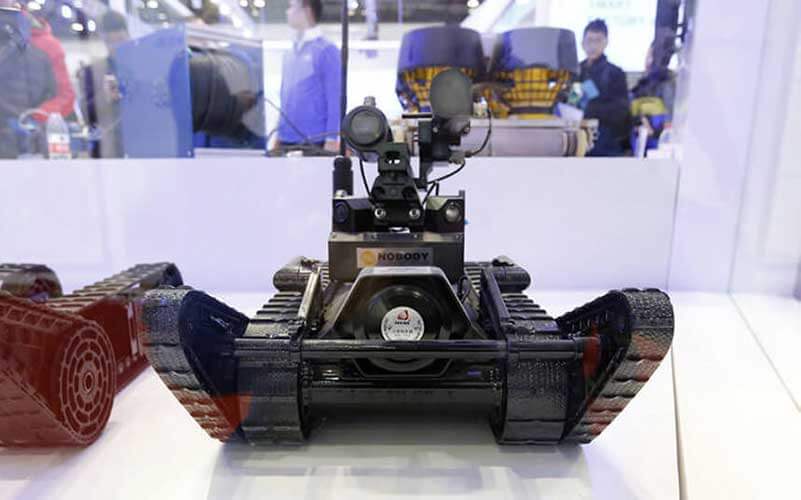- Big data plays a vital role in the war on terror
- Toy-sized battle robots with grenades and assault rifles
- Dfuze and PredictifyMe – predicting the unpredictable
- With the Internet of Things, every device has an IP address
- New colour-changing sensors can detect multiple explosives within second
Tuesday 22nd March was a horrendous day for Belgium, the whole of Europe and, indeed, the world. Preventing catastrophic acts of terror such as these from happening again means always staying one step ahead of the game. There are many new technological innovations; from processing data at speeds we could never have imagined before to the development of recognition software, the implementation of drones, the use of sensor technology and the Internet of Things. In this article we explore some of the technological developments that can help protect our freedom in these increasingly hostile and turbulent times.
Big data plays a vital role in the war on terror
How the military and intelligence agencies use big data is justifiably classified. Based on how it is used in other industries, however, we can get a pretty good idea of how big data features in the war on terror. In order to fight the enemy, it is critical to get an in-depth understanding of that enemy, how they operate, what technology they use, and nothing gives us better insights than big data. The same way in which businesses leverage data in order to gain a better understanding of their clients, the military can use data to get an understanding of backgrounds, motives, modus operandi, methods of communication. Once these elements are understood, the information can be leveraged to learn all there is to know about terrorist networks; who finances them, who supplies them, who supports them and who are the informants. Big data can also be used to establish patterns and make predictions on which population groups or what type of person would be most likely to join a terrorist organisation.
In a huge project by the Qatar Computing Research Institute, big data was used to scrutinise and analyse social media such as Facebook and Twitter in order to locate the origins of supporters of terrorist organisation ISIS. Over a period of three months, researchers monitored and analysed three million tweets. They managed to pinpoint important characteristics and patterns among tweets that showed support for ISIS and terrorism, as well as those who opposed it. Using these findings, the researchers created algorithms that were able to group users as pro- or anti-ISIS with an accuracy of nearly 90 percent. It is clear to see the value of being able to identify which people would be most likely to join ISIS as this could help limit the proliferation of extremist groups.
Not only information from social media is used to get an understanding of terrorists. Surveillance data from drones gathered in areas where suspicious activity is taking place can also provide valuable information, especially when this real-time information is combined with other data sources. Information like this can help establish connections between people and events and identify the location of terrorists and even make predictions of the where they may move to in the future. Another way terrorists can be traced is by monitoring outbreaks of diseases such as polio. Many terrorist groups are opposed to vaccinations so any information on outbreaks of certain diseases in certain areas could be extremely valuable.

Toy-sized battle robots with grenades and assault rifles
At the World Robot Conference in Beijing, China recently unveiled toy-sized battle robots with grenades and assault rifles. These ‘armed attack’ robots are designed for counter terrorism operations and are planned to be integrated in China’s military force. These robots have been designed in three versions: an attacker robot – armed with grenade launchers and rifles that minimise recoil – a reconnaissance robot capable of detecting hazardous gases, and a bomb disposal robot. The reconnaissance robot is apparently designed to be able to fit into a soldier’s backpack. Another robot used in the war against terrorism is the PackBot – a machine that locates and diffuses bombs. The PackBot will eventually carry out complex tasks without any human interference and will be very effective in detecting terrorists and explosives. PackBot can gather information from devices such as streetlights, bus shelters and sensors and combine it with its own data to make decisions. Various countries are developing autonomous robots that are able to eliminate terrorists and free hostages. These bots will be outfitted with biometric recognition technology and connect with sources that supply image data and location information to help identify potential terrorists.
Dfuze and PredictifyMe – predicting the unpredictable
The use of prediction software in the fight against terrorism is also referred to as ‘predictive policing’. This form of counterterrorism has been on the increase and the ISS (Intelligent Software Solutions) behavioural analysis tool Dfuze is already used in over forty countries. Dfuze was used at the 2012 Olympics in London to pinpoint high risk areas to enable police forces to increase security presence. The software was also used to investigate the Boston bombings in 2013. The Dfuze system is a database which holds information on all terrorist attacks that have ever taken place. Governments can access this data to analyse previous attacks and share information, leading to more efficient methods of communication between nations. With the Dfuze system, specialists are able to establish and analyse trends and patterns, future attack hotspots, the types of explosives, modus operandi and help them predict, prepare for or even prevent any future terrorist attacks. In the past, this type of work was done by analysts trawling through mountains of information, initially in paper files and later on computers.
Another predictive solution, launched in 2014, is PredictifyMe. The technology is simple to deploy, can help predict an impending terrorist attack and secure areas against it. PredictifyMe uses 200 indicators, such as public holidays, the weather, attacks in nearby countries, sports or other events and even video releases on social media to predict whether and when a terrorist attack is likely to happen. PredictifyMe have indicated that it is able to predict an attack within three days with an accuracy of over 70 percent.
With the Internet of Things, every device has an IP address
With more and more devices connecting to not only the Internet but also to each other, the Internet of Things enables increased convenience, efficiency and energy conservation. With internet connectivity moving away from the traditional laptops, tablets and smartphones and migrating toward wearables and household devices such as fridges and washing machines, the IoT can also easily be used for monitoring, location tracking, identification, surveillance and gaining access to networks. Every device will have an IP address and security experts have indicated that surveillance services will able to intercept signals of networked devices in much the same way as they intercept cell phone signals. Information from speeches, satellites, videos and news is all collected and used to monitor and analyse activities, enabling intelligence services to close in on terrorists.
New colour-changing sensors can detect multiple explosives within seconds
In December 2015, scientists developed a new colour-changing sensor that is able to identify and quantify multiple explosives such as DNT, PETN, tetryl, RDX and TNT within ten seconds. The fluorescent sensor gives out information about the type of explosive and how much of it is present in a sample. PETN and RDX for example, have been used in terror plots because they are hard to detect by sniffer dogs. The colour-changing sensor is made from light-emitting nanomaterials or ‘quantum dots’ to which receptors that target the explosive are attached. Each explosive that binds to the quantum dot emits a different colour. These are then analysed in order to generate a unique ‘fingerprint’ for each compound. This makes it possible to detect multiple explosives with one single test.
Conclusion
The destruction caused by terrorism is out of control and terrorists are proving more and more adept at using sophisticated technology. In order to have a fighting chance in the war on terror, we need to stay one step ahead and keep developing new, improved technology, eradicate conflicting laws and different priorities and replace them with a collective approach which includes timely sharing of information and true collaboration. This will provide a basis from which we can protect ourselves from the threat of terrorism and safeguard our fundamental rights and our freedom.
Share via:



